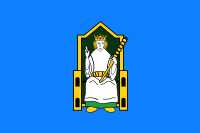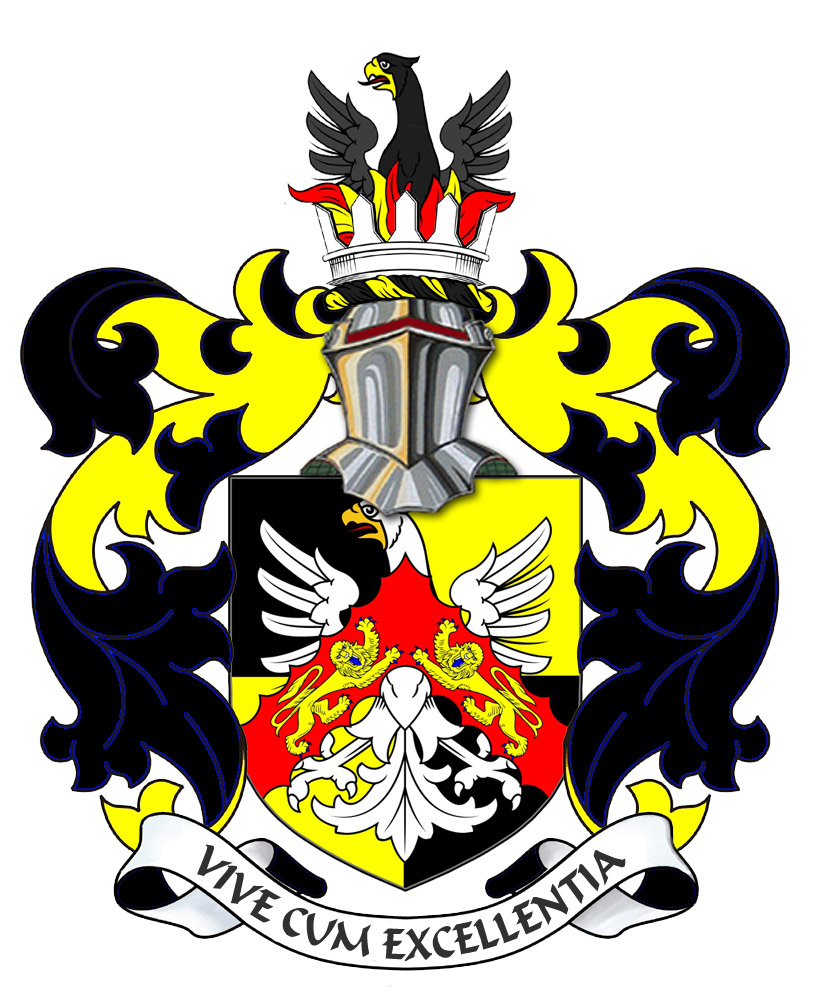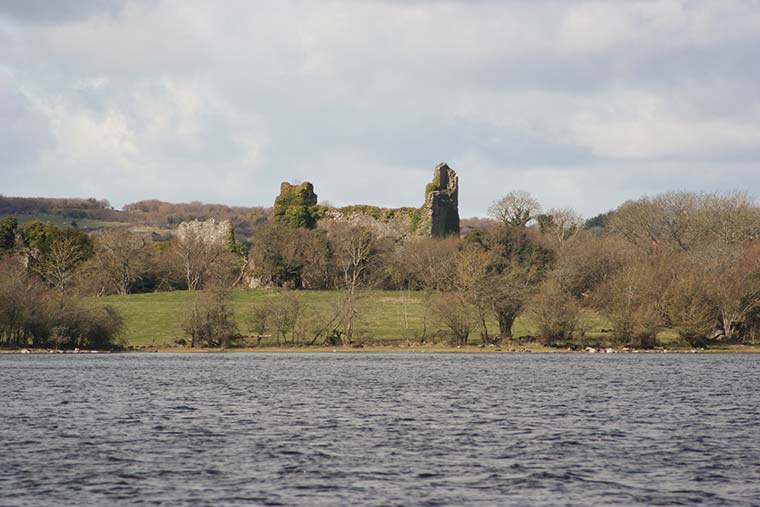



Lord Baron of Inchcleraun IslandThis island formerly formed part of the kingdom of Hy-Many. It is now included in the County Longford. Clothra was the mother of Lughaidh who was, at a remote period, king of Ireland. “In the reign of Lughaidh the lakes Neagh and Ree began to make their appearance.” St. Diarmid, patron of Inis Clothrann was brother of St. Fedliminus, who was Bishop of Kilmore; both were descended from Dathy, the last pagan king of Ireland, who was killed in year 427.
St. Diarmid was the teacher of St. Ciaran of Inisangin, afterwards the founder of Clonmacnoise. Inis Clothrann, as a religious seat, is probably older than Clonmacnoise. St. Diarmid wrote a pious work which the learned Colgan states was in his possession. His festival is honoured on the Ioth of January. St. Diarmid's church, measuring eight feet by seven, is said to be the smallest in Ireland. To the north-west of Grianan Meadhbha, or Queen Meave's palace, is Temple Clogas, the first church erected by St. Diarmid on Inis Clothrann. The belfry of this church was thirty feet high and its bell so loud-sounding as to be heard a distance of seven miles. It is one of the few ancient square belfries now existing in Ireland.
“I shall visit Inis Clothrann,
Inchcleraun (Irish: Inis Cloithrinn), also called Quaker Island or Holy Island, is an island situated inLough Ree on theRiver Shannon, in County Longford of centralIreland.[1][2][3][4][5] which was granted to Baron Delvin in 1552. The island has the ruins of St. Diarmaid’s Monastery, a monastery founded by Diarmaid the Just in AD 560. These buildings constitute a National Monument. Inchcleraun island has(143 acres) located in the centre of Lough Ree , with Knockcroghery , County Roscommon to its west and Newtowncashel , County Longford to its east..
Inchcleraun Priory
early monastic site, founded 6th century (c.540 or probably earlier) by St Diarmuid
(Dermod);
Granted to Baron Delvin 1552
Cashel MonasteryAugustinian Canons Regular ruins near parish church purportedly remains of a foundation dependent on Inchcleraun
Grant 1552 - Holy Island - Inchcleraun Island, Lough Ree With the government showing little inclination to reach a more permanent settlement with the O’Farrells, Delvin led a raid across Lough Ree shortly before Christmas 1548.21 Despite opposition from the nearby Dillons, it seems that Delvin succeeded in gaining a foothold in the southern reaches of the O’Farrell lordship. In 1552 the crown granted the dissolved monastery of Holy Island, Lough Ree, to the baron, together with associated lands and tithes.22 This was more than a mundane grant of ecclesiastical land in one’s county of residence, which many peers, gentry and officials received: it must be viewed in the context of mid-Tudor expansionism. The government was willing in 1553 to nominate a ‘captain and governor’ of the O’Farrell Boy branch, yet allowed Delvin to build up a landholding profile within the branch’s sphere of influence on the banks of Lough Ree. Lord Deputy Croft and his advisors described these lands as in ‘a waste, wylde Countrey amonge the yrishe where lytle obedyence doth contynue’, but Delvin had announced his intention to fortify his new territory.23 The Baron Delvin was also granted the monastic site at Granard, in the northeast of the Annaly lordship in what is now called the County Longford; this also represented a projected expansion of English influence. Before the 15th century Granard Abbey had been an exclusively English foundation, but papal order forced it to admit Gaelic men. The house quickly lost its English identity, and fell completely under O’Farrell patronage.24 Thus Delvin’s acquisition of Granard represented an effort to reincorporate former English church lands into English society. Confirmation of the achievements of Baron Richard in enhancing the importance of his house came in 1553, when he joined O’Connor Roe in a devastating raid on the MacDermots of Moylurg, a lordship situated west of the Annaly and a considerable distance from Delvin territory.25 County Longford Monastery of Holy Island Lough Ree also Granted to Lord Delvin in 1552 CITATION Inchcleraun (Inis Cloithrinn) (also known locally as Quaker Island) is home to a monastery founded by St Diarmuid in 560. St Diarmaid the Just was a teacher of St. Ciaran of Clonmacnoise, one of the Twelve Apostles of Ireland. The island is said to have been named after ‘Clothra’, sister of Queen Maeve who retired to the island after her husband Ailill, Kind of Connacht, was killed in battle in the 1 st century. On the east shore of the island she built a fortified garden called ‘Grianan Maeva’ (The beautiful sunny spot of Maeve). Apparently she also died on the island at the hands her nephew who killed her while she was bathing with a lump of cheese fired from a sling shot. Today the ruins of the monastery and seven churches remain, including one church with an usual square belfry which is visible from the shore of Lough Ree (round towers were more typical of the time period).
Annalistic references [edit]
Reference: History of Longford
Louqh Ree (for steamer service see pink pages) is smaller than Derg, being 17 miles in length. Formerly it was called Lough Ribh, and sometimes "Great Lough Allen." A boat for visiting Lough Ree may be hired at Athlone, with or without rowers. The numerous promontories, bays, and creeks of the lake greatly add to the charm and variety of its Bcenery, and some of the islands are very beautiful; but it all wants sun. This "Lough of the Kings" formed the frontier line between Hy-Many, the principality of the O'Kellys, on the west, and " Kilkenny West," in the kingdom of Meath, on the east. Among several interesting islands we may mention Inis Clothrann (or Quaker Island), named after the sister of Queen Mab (or Meave). On the highest point of it once stood that queen's palace, and it was on the sunny strand below that she was bathing when the cowardly Ulster chief struck her dead with a stone from his sling. Professor Stokes states that St. Dermot is said to have lived here about the year 500; and many remains of churches and buildings remain. "The monastery of Inisbofin (or White Cow Island) is, in some respects, the most interesting of any upon Lough Ree, because its foundation is attributed to St. Rioch, the nephew of St. Patrick, ... a Briton or Welshman by birth." On Bare Island no hares are now living to explain the name; they have relinquished it in favour of the later tenant, Lord Castlemaine. On the western shore is the interesting ruin of Randoum Castle, "a famous spot in Irish history for the last 2000 years." In ancient times it was called John's (Eoin) House after a local Celtic saint; when the Normans, who hated the Celts, came and "established a castle of the Knights Hospitallers, they changed the dedication to that of St. John the Baptist. The castle still stands, with a round tower, "a church dedicated to the Holy Trinity, and a fortified wall, "unique in Ireland." |
Tenures Abolition Act 1662 - Rights to Sit in Parliament Law of Ireland List of Townlands of Longford Annaly The Seigneur About Longford English Pale Lord of St. Brigit's Longford Abbey Est. 1578 Market & Fair Court Barons News Irish Kingdoms Fishing & Dams Rights Rights of Lords & Barons Feudal Barons Styles and Dignities Lord Baron Longford Baron de Delvyn Longford Map Lord Baron of Delvin Baron of Temple-Michael Baron of Annaly Lord Conmaicne Baron Annaly Baron Lerha Granard Baron AbbeyLara Baronies of Longford Princes of Conmhaícne Angaile or Muintir Angaile Baron Lisnanagh or Lissaghanedan Baron Moyashel Moiety of Ardagh Baron Rathline Captainship of The Slewght William in the Annaly Grants to Delvin Baron Inchcleraun Abbey of All Saints Kingdom of Uí Maine Baron Dungannon Baron Monilagan - Babington Baron Columbkille Kingdom of Breifne Baron Kilthorne Baron Granarde Count of Killasonna Baron Skryne Baron Cairbre-Gabhra AbbeyShrule Fiefs of the Islands Feudal Westmeath The Island Lords Fief Worship Channel Island History Fief Blondel Fief Blondel Merchandise Events Blondel and King Richard Fief Coin Feudal Guernsey Titles The Feudal System Flag & Arms Castle Site Map Disclaimer Blondel Myth Dictionary
Feudal Baron of Longford Annaly - Baron Longford Delvin Lord Baron &
Freiherr of Longford Annaly Feudal Barony Principality Count Kingdom of Meath - Feudal Lord of the Fief
Blondel of the Nordic Channel Islands Guernsey Est. 1179
Feudalherr - Fief Blondel von der Nordischen Insel Guernsey Est. 1179
Counselor George Mentz Esq. - Seigneur Feif Blondel - Lord Baron Longford Annaly Westmeathwww.BaronLongford.com * www.FiefBlondel.com |






